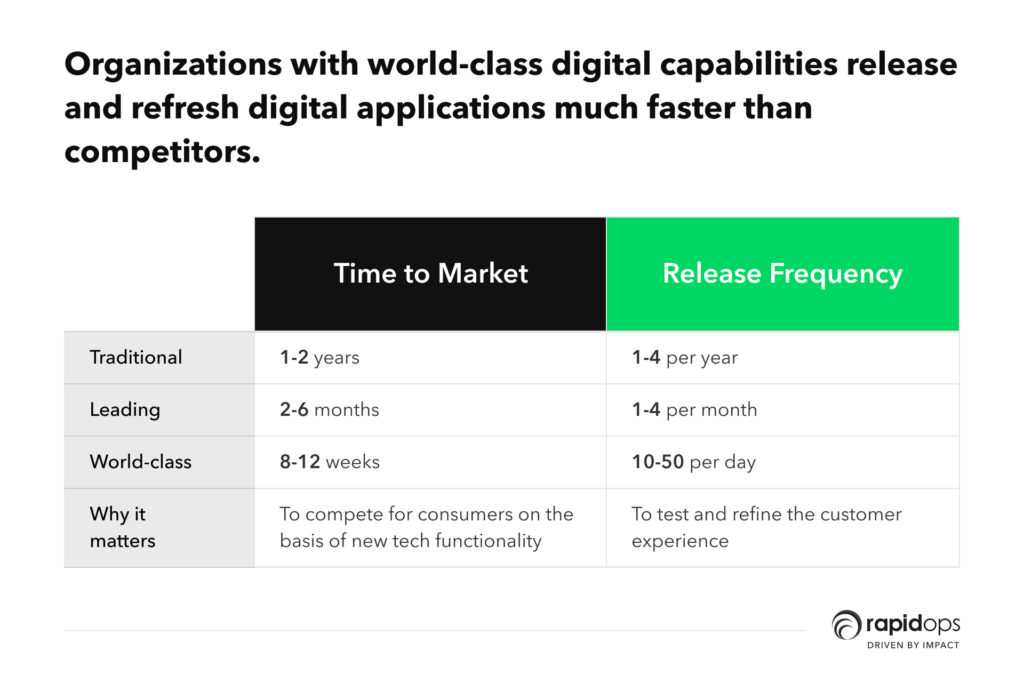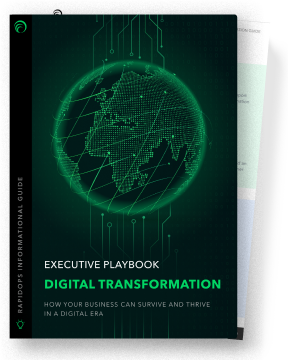- Transformation
- March 2022
Digital Transformation Success - The Key Roles and KPIs You Must Know
As per Gartner, half of the organizations that take digital transformation initiatives fail to define key metrics for tracking their transformation success.
Our detailed digital guide on transformation covered its meaning, benefits, challenges, meaning, framework, technologies, examples, KPIs, essential components, and trends.
This article will cover the essential roles and KPIs that business leaders can measure for organizational transformation's progress or success.
Key roles in your digital organizational transformation
Assembling the right team is crucial for the success of your digital transformation initiatives. This section will see the key roles essential for your digital organizational change.
To get started, your digital team must comprise good leaders or C-level executives with a budget, influence in decision-making, and respect amongst their peers.
Companies have various titles for the people that spearhead their digital transformation initiative, namely,
- Chief Digital Officer (CDO)
- Chief Strategy Officer (CSO)
- Chief Information Officer (CIO)
- Chief Operating Officer (COO)
- Chief Technology Officer (CTO)
How the CEOs view digital transformation as an initiative will define whom they place in charge of their organizations' transformation.
This depends on the business use case; for instance, if the CEO feels that streamlining the entire business process is the focus of digital transformation, he might assign it to the COO.
1. Chief Data Officer
Data analytics comes in handy when business leaders want to start their transformation initiative because it helps them make sound decisions and select the right solutions. Enterprise data architects' chief data officers can align their IT tools with their organizational blueprint and connect it with their business strategy.
2. Chief Innovation Officer working with the CTO
CIOs help merges business and technology with their strong IT background. Their role is to take charge of organizational innovation by clubbing business goals, technological capabilities, and technical infrastructure.
3. Chief Digital Officer
Large-scale organizations often require a digitally savvy individual who must help other business executives accommodate their cultural change. This cultural change is crucial to organizational transformation and becoming truly digital-first.
4. Technology-Innovation or Solution Delivery Architects
They are hired to work alongside the CIO or CDO to remove any blockers, such as informational and technical gaps, to embrace a company-wide digital strategy. They are also responsible for creating the technical solution framework and must match it to meet the end goals of organizational transformation.
5. User Experience (UX) expert
Your product or service is an experience for your customer base. The result of our digital transformation initiative is to engage your audience with usable and valuable products or services. Most importantly, you want your audience to interact with your offerings personally while it helps them resolve their issues.
Having the right UX resources helps map the customer touchpoints, identify gaps, and realize better opportunities for elevating the touchpoints. Design thinking is at the core of this entire process, and a user experience expert is a valuable addition to having successful digital transformation.
6. Integrators such as Cloud Architect
Integrators work at specific departments to ensure that each team implements new digital solutions soundly. The sudden acceleration of digital transformation will push businesses to move their applications and related data to the cloud. If business leaders factor in the costs of rewriting applications, then the budget will overshoot. Business leaders will have to use technologies that enable phased approaches to application development, rather than going all out on the development and burning down their budget.
Important KPIs to track your digital transformation success
Because planning digital transformation initiatives differ business-to-business, setting the right key performance indicators (KPIs) to measure digital transformation success becomes the real challenge.
Digital transformation also includes a substantial cultural change, so it is often resisted by the workforce and is one of the significant causes of failure.
Many departments might overthink the metrics and see them as an intention to make them look bad or show their failures.
Why does the need for digital transformation arise?
Improving previously inefficient processes or legacy systems is the core business objective of digital transformation. So, it becomes essential for businesses to set clear goals from the outset of the organizational transformation initiative.
These questions will help you gain better clarity of how you can set clear KPIs
- Where is our business right now in the journey?
- Do we have any intended digital destination?
- How will we measure our wins once we reach that destination?
- Do we have a roadmap to reach that digital destination?
Some important digital transformation KPIs:
The best digital transformation KPIs are always tied to your business's health and are created based on the core business strategy. So, business leaders must measure what truly matters to their core process.
1. Return on digital investments

Start by measuring the return on investment (ROI) of new technologies integrated into your business processes. The benefits of such incorporation must always outweigh costs related to resource usage and its overall investment.
Here is the formula for calculating the ROI of a technology investment:
ROI = net gain/cost
The ROI evaluation can also be done by tracking the business process improvements brought by the digital tools. The business process improvement can be counted against the seamless achievement of your strategy goals like
- Cost savings
- Increased productivity
- Customer experience improvements
- Increased business growth
The goals mentioned above must always play into your overall digital transformation plan. Tracking them using your KPIs ensures you achieve the transformational initiative's intended target.
We will also advise that business leaders determine investment and value metrics and set the time frame to accomplish these predetermined goals.
2. Cost efficiency

The goal behind adopting the digital-first approach via transformation initiatives is to utilize your resources most optimally. For instance, you apply chatbots to improve customer service and allocate your manual task force towards resolving more serious customer support issues. Calculate the outcomes or benefits that you achieved using chatbots. Frame questions like
- What is the percentage of consumer compliance the chatbot solved?
- How much satisfied is your customer with the responses?
- What is the degree of cost-saving achieved via chatbot implementation?
3. Engagement, adoption, and performance

This includes the level of engagement of digital transformation tools amongst your workforce by adoption. This is one of the most extensive business transformation metrics.
A higher level of adoption shows the ease of use of the tools and proves they are resolving previously discovered roadblocks. Are the tools positively impacting the workforce's overall job performance from an end-user perspective?
Is it addressing the pain points and improving your employees' overall user experience?
4. Better productivity and agility

Employee productivity is another important metric that helps measure the overall operational efficiency of digital transformation initiatives.
If it creates the required value by improving employee productivity and the business process sees the benefit of including automation, then your organizational transformation is a success.
5. Enhancement in customer experience

How has the digital initiative affected your customer base? Are your automated workflows making it easier for the customers to engage with you and resolve their issues?
Start evaluating your organization's availability, measuring client data security, and checking system performance. Have a customer feedback system in place that can help you conveniently measure the success of going digital.
Bonus KPI: Innovation achieved through technology
What worked ten years back is now obsolete, and the pace with which technology is growing, you might be surprised how fast digital tools might get irrelevant in the coming 5-7 years.
So, the fear of not innovating enough to match the competition will always be there. It would help if you implemented digital transformation tools and technologies that will stay with your processes and refine your operational efficiency.
After all, you will demand a handsome ROI in return for the budget you will break for getting the digital transformation initiatives underway.
Measure the success of digital transformation against the future scope of applied technology innovation in your business process. This way, you will never compromise on faster adaptability and better scalability.
Successful digital transformation deployments often include technology-supported changes to business models, product offerings, systems, and processes to enhance customer value, reduce costs, and fast growth.
Although KPIs are unique to businesses, the innovation rate can be an excellent leading indicator for assessing efficiency and return on digital investments.
Concluding thoughts: Embark on a successful digital adoption journey

As the above statistic proves, time to market and release frequency are significant factors in capturing audiences' attention and refining their experience with your business.
Many businesses have started taking their digital-first initiatives to push their boundaries with the help of digital transformation.
Yet, many of the business leaders are still not sure whether to embark on the journey to become a trustworthy digital business or not. And even if they are ready, they are not confident about its benefits, its roadmap, or setting its KPIs.
Businesses can follow a simple process to start defining their KPI objectives by aligning them with their organizational goals. After that, they must focus on a limited set of relevant metrics matching the goals.
Then accurately set the level of measurements against past performance and ensure that the metrics are measurable, detailed, and insightful.
After doing all this, they must rope in a seasoned digital product development company like Rapidops as their digital transformation stakeholder to ensure organization-wide implementation of their strategies.
Rapidops is an established name for creating digital products or strategies to stay ahead of the curve and enjoy maximum efficiency in a competitive market. If you want to understand how to transform your business with solid digital initiatives, then get in touch with our experts.





